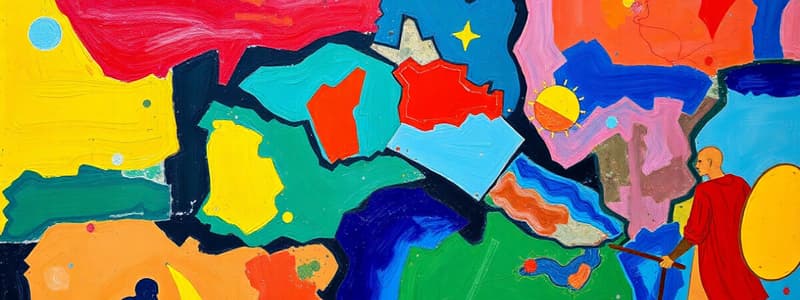Podcast
Questions and Answers
What was the structure of ancient Rome before it became an empire?
What was the structure of ancient Rome before it became an empire?
- Kingdom
- Republic
- Empire
- All of the above (correct)
What was the role of the Senate in the Roman Republic?
What was the role of the Senate in the Roman Republic?
The Senate was a council of citizens that ruled Rome.
What significant event marked the end of the Western Roman Empire?
What significant event marked the end of the Western Roman Empire?
The deposition of Romulus Augustulus by the Germanic chieftain Odoacer in 476 AD.
What were some effects of the economic and social crises in the Roman Empire?
What were some effects of the economic and social crises in the Roman Empire?
Constantinople remained known as the Byzantine Empire until its fall in 1453.
Constantinople remained known as the Byzantine Empire until its fall in 1453.
Who was the emperor during the height of the Byzantine Empire's splendor?
Who was the emperor during the height of the Byzantine Empire's splendor?
The ban on icons in the Byzantine Empire is referred to as the ______.
The ban on icons in the Byzantine Empire is referred to as the ______.
What were the luxury goods traded in the Byzantine economy?
What were the luxury goods traded in the Byzantine economy?
Match the following terms related to Byzantine architecture and art:
Match the following terms related to Byzantine architecture and art:
What was the result of the Eastern Schism?
What was the result of the Eastern Schism?
Flashcards are hidden until you start studying
Study Notes
The End of the Roman Empire
- Ancient Rome: Monarchy (753 BC), Republic ruled by the Senate (509 BC), and eventually an Empire ruled by an Emperor (27 BC).
- Barbarians:
- Huns: Nomadic animal herders who attacked Germanic people, leading to Germanic migration across Roman borders.
- Germanic People: Nomads, farmers, and livestock breeders; they lived near Roman borders due to a milder climate and the riches of the empire.
- 3rd Century Crisis in Rome:
- Barbarian Pressure: Germanic tribes crossed Roman borders due to Hun attacks, creating military weakness and mass migration.
- Empire's Maximum Expansion: Resources and trade routes were stretched thin, resulting in fewer slaves, less spoils from war, and less labor.
- Depopulation of Cities: People moved to rural areas to escape conflict and economic hardship.
- Impact: Theodosius divided the Roman Empire in 395 AD, leading to the Western Roman Empire (Rome) and the Eastern Roman Empire (Constantinople).
The Byzantine Empire
- Historical Evolution:
- 6th Century (Justinian, 527-565):
- Period of great prosperity.
- Reunited the Roman Empire (recaptured lost territories).
- 7th Century: Beginnings of decline as wealthy provinces were conquered by Muslims.
- 11th Century: Deep crisis, leading to the fall of Constantinople to the Turks in 1453, marking the end of the Byzantine Empire.
- 6th Century (Justinian, 527-565):
- Government and Administration:
- Emperor (Basileus): Military, administrative, and religious leader.
- Specialized Officials: Carried out the emperor's orders.
- Corpus Juris Civilis: A unified legal system, ensuring common laws throughout the empire.
- Provincial Administration: Provinces were governed by political and military leaders.
The Byzantine Economy
- Basis: Agriculture, with large estates (latifundia) owned by nobles and monasteries, worked by serfs.
- Craft Production: Specialty goods such as luxury items, often traded throughout the empire.
- Commerce:
- Strategic location between Europe and Asia, and the Mediterranean and Black Seas.
- Traded goods include:
- Silk (from China)
- Ivory and pearls (from India)
- Amber, furs, and wheat (from Northern Europe)
Byzantine Society
- Hierarchy:
- Emperor
- Patriarch of Constantinople
- High Clergy, palace nobility, and military nobility
- Artisans, merchants, soldiers, and free peasants
- Servants or slaves
The Church and its Problems
- Iconoclast Struggles (8th-9th Century):
- Dispute: Debates over the use of icons (religious images).
- Conflict: Led to social unrest.
- Outcome: The cult of images was ultimately re-established.
- Eastern Schism (11th Century):
- Separation: Split between the Catholic and Orthodox Churches.
- Dispute:
- Power struggle between the Patriarch of Constantinople and the Pope of Rome..
Byzantine Art
- Architecture:
- Materials: Primarily brick.
- Columns: Used for support.
- Arches: Semicircular.
- Church Plans: Rectangular, square, octagonal, or Greek cross shape; emphasized centralized plans.
- Mosaics:
- Use: Decoration for walls and domes of churches.
- Icons:
- Description: Religious images painted on wood, often using gold.
- Subject Matter: Depicted religious scenes and figures.
Hagia Sophia (Holy Wisdom)
- Construction:
- Massive dome - unprecedented size for its time.
- Used a unique mixture of architectural elements to support its weight (pillars, arches, pendentives, and smaller domes).
- A ring of 40 windows in the dome's drum created a spectacular effect.
- Significance: One of the most impressive and influential examples of Byzantine architecture.
Studying That Suits You
Use AI to generate personalized quizzes and flashcards to suit your learning preferences.



